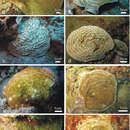Description
provided by Zookeys
Corallum: The specimen is 1.5 cm high from the base in its original growth position, and 7.5 × 5.2 cm wide. The holotype is oval-shaped, attached at the centre with free margins and sunken in the central part (Figures 4d, 6b). At the opposite ends of its largest diameter the corallum margins bend in different directions with respect to the plane of the central encrusting part (upwards at the left-hand side and downwards at the right-hand side of Figure 6b). The corallum surface is irregularly undulated due to the presence of well-developed carinae, which are symmetrical and thick in the central part (Figure 6d) and become increasingly shorter, lower, and more inclined towards the margins (Figure 6c).
Calices: Arranged in short rows, mostly distinct (Figure 6d) especially towards the margins where the series become shorter (Figure 6c). Calices and series of calices are arranged parallel to each other, concentric and separated by wide and rounded carinae with variable vertical development and inclination with respect to the corallum surface (Figures 4d, 6c). Where carinae separate, single calices or short series become distinct. In these cases, short carinae can resemble proximal cushions, the typical features forming in the agariciid genus Leptoseris when the inner or proximal side of an inclined corallite is raised into a cushion-like structure (Dinesen 1980).
Columella: Well-developed, sitting deep in the fossa (Figure 6d) made by one or more processes derived from the inner end of the radial elements.
Radial elements: Radial elements are continuous across the carinae, regularly spaced and equal. Lateral faces bear regularly distributed, parallel lines of clumped granules (Figure 7e). The upper margin of the radial elements is minutely beaded and typically attains a zigzag pattern with ornamentations at the angles (Figure 7f).
Color: The in vivo color was light brown with the top of the collines and the margins of the colony paler.
- license
- cc-by-3.0
- copyright
- Tullia I. Terraneo, Michael L. Berumen, Roberto Arrigoni, Zarinah Waheed, Jessica Bouwmeester, Annalisa Caragnano, Fabrizio Stefani, Francesca Benzoni
- bibliographic citation
- Terraneo T, Berumen M, Arrigoni R, Waheed Z, Bouwmeester J, Caragnano A, Stefani F, Benzoni F (2014) Pachyseris inattesa sp. n. (Cnidaria, Anthozoa, Scleractinia): a new reef coral species from the Red Sea and its phylogenetic relationships ZooKeys 433: 1–30
- author
- Tullia I. Terraneo
- author
- Michael L. Berumen
- author
- Roberto Arrigoni
- author
- Zarinah Waheed
- author
- Jessica Bouwmeester
- author
- Annalisa Caragnano
- author
- Fabrizio Stefani
- author
- Francesca Benzoni
Distribution
provided by Zookeys
This species has been sampled along the Saudi Arabian coast in the northern and central Red Sea (Figure 8). It was not recorded in the Farasan Islands, nor further south in the Kamaran Islands, Yemen. To date, its distribution appears to be limited to the Red Sea.
- license
- cc-by-3.0
- copyright
- Tullia I. Terraneo, Michael L. Berumen, Roberto Arrigoni, Zarinah Waheed, Jessica Bouwmeester, Annalisa Caragnano, Fabrizio Stefani, Francesca Benzoni
- bibliographic citation
- Terraneo T, Berumen M, Arrigoni R, Waheed Z, Bouwmeester J, Caragnano A, Stefani F, Benzoni F (2014) Pachyseris inattesa sp. n. (Cnidaria, Anthozoa, Scleractinia): a new reef coral species from the Red Sea and its phylogenetic relationships ZooKeys 433: 1–30
- author
- Tullia I. Terraneo
- author
- Michael L. Berumen
- author
- Roberto Arrigoni
- author
- Zarinah Waheed
- author
- Jessica Bouwmeester
- author
- Annalisa Caragnano
- author
- Fabrizio Stefani
- author
- Francesca Benzoni

